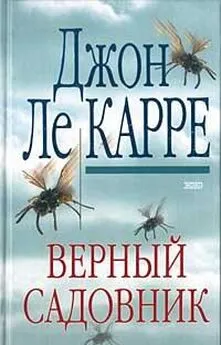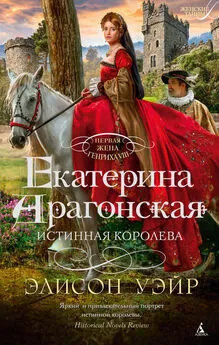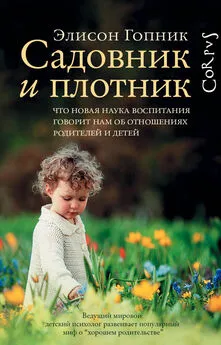Элисон Гопник - Садовник и плотник [litres]
- Название:Садовник и плотник [litres]
- Автор:
- Жанр:
- Издательство:Литагент Corpus
- Год:2019
- Город:Москва
- ISBN:978-5-17-101296-0
- Рейтинг:
- Избранное:Добавить в избранное
-
Отзывы:
-
Ваша оценка:
Элисон Гопник - Садовник и плотник [litres] краткое содержание
Садовник и плотник [litres] - читать онлайн бесплатно ознакомительный отрывок
Интервал:
Закладка:
George, Madeleine, and Candice L. Odgers. “Seven Fears and the Science of How Mobile Technologies May Be Influencing Adolescents in the Digital Age.” Perspectives on Psychological Science 10 (November 2015): 832–851.
Gergely, György, Harold Bekkering, and Ildikó Király. “Rational Imitation in Preverbal Infants.” Nature 415, no. 6873 (2002): 755–756. doi: 10.1038/415755a.
Gettler, Lee T., Thomas W. McDade, Alan B. Feranil, and Christopher W. Kuzawa. “Longitudinal Evidence That Fatherhood Decreases Testosterone in Human Males.” Proceedings of the National Academy of Sciences 108, no. 39 (2011): 16194–16199. doi: 10.1073/pnas.1105403108.
Giedd, Jay N., Jonathan Blumenthal, Neal O. Jeffries, F. Xavier Castellanos, Hong Liu, Alex Zijdenbos, Tomáš Paus, Alan C. Evans, and Judith L. Rapoport. “Brain Development During Childhood and Adolescence: A Longitudinal MRI Study.” Nature Neuroscience 2, no. 10 (1999): 861–863. doi:10.1038/13158.
Glocker, Melanie L., Daniel D. Langleben, Kosha Ruparel, James W. Loughead, Jeffrey N. Valdez, Mark D. Griffin, Norbert Sachser, and Ruben C. Gur. “Baby Schema Modulates the Brain Reward System in Nulliparous Women.” Proceedings of the National Academy of Sciences 106, no. 22 (2009): 9115–9119. doi: 10.1073/pnas.0811620106.
Goldin-Meadow, Susan, Susan A. Gelman, and Carolyn Mylander. “Expressing Generic Concepts with and without a Language Model.” Cognition 96, no. 2 (2005): 109–126. doi: 10.1016/j.cognition.2004.07.003.
Gopnik, Alison. The Philosophical Baby: What Children’s Minds Tell Us About Truth, Love, and the Meaning of Life . New York: Farrar, Straus and Giroux, 2009.
Gopnik, Alison. “Scientific Thinking in Young Children: Theoretical Advances, Empirical Research, and Policy Implications.” Science 337, no. 6102 (2012): 1623–1627. doi: 10.1126/science.1223416.
Gopnik, Alison, Thоmas L. Griffiths, and Christopher G. Lucas. “When Younger Learners Can Be Better (or at Least More Open-Minded) Than Older Ones.” Current Directions in Psychological Science 24, no. 2 (2015): 87–92. doi: 10.1177/0963721414556653.
Gopnik, Alison, and Henry M. Wellman. “Reconstructing Constructivism: Causal Models, Bayesian Learning Mechanisms, and the Theory Theory.” Psychological Bulletin 138, no. 6 (2012): 1085. doi: 10.1037/a0028044.
Gould, Stephen Jay. Ontogeny and Phylogeny . Cambridge, Mass.: Harvard University Press, 1977.
Graham, Susan A., Samantha L. Nayer, and Susan A. Gelman. “Two-Year-Olds Use the Generic/Nongeneric Distinction to Guide Their Inferences About Novel Kinds.” Child Development 82, no. 2 (2011): 493–507. doi: 10.1111/j.1467–8624. 2010.01572.x.
Graves, Christopher J., Vera I. D. Ros, Brian Stevenson, Paul D. Sniegowski, and Dustin Brisson. “Natural Selection Promotes Antigenic Evolvability.” PLOS Pathogens 9, no. 11 (2013): e1003766. doi: 10.1371/journal.ppat.1003766.
Grossmann, Karin, Klaus E. Grossmann, Heinz Kindler, and Peter Zimmermann. “A Wider View of Attachment and Exploration: The Influence of Mothers and Fathers on the Development of Psychological Security from Infancy to Young Adulthood.” In Handbook of Attachment: Theory, Research, and Clinical Applications (2nd ed.), edited by Jude Cassidy and Phillip R. Shaver, 857–879. New York: Guilford Press, 2008.
Haight, Wendy L., Xiao-lei Wang, Heidi Han-tih Fung, Kimberley Williams, and Judith Mintz. “Universal, Developmental, and Variable Aspects of Young Children’s Play: A Cross-Cultural Comparison of Pretending at Home.” Child Development 70, no. 6 (1999): 1477–1488. doi: 10.1111/1467–8624.00107.
Halberda, Justin, Michele M. M. Mazzocco, and Lisa Feigenson. “Individual Differences in Non-verbal Number Acuity Correlate with Maths Achievement.” Nature 455, no. 7213 (2008): 665–668. doi: 10.1038/nature07246.
Harris, Paul L. Trusting What You’re Told: How Children Learn from Others . Cambridge, Mass.: Harvard University Press, 2012.
Harris, Paul L. The Work of the Imagination . Oxford: Blackwell Publishing, 2000.
Harris, Paul L., and Kathleen H. Corriveau. “Young Children’s Selective Trust in Informants.” Philosophical Transactions of the Royal Society B: Biological Sciences 366, no. 1567 (2011): 1179–1187. doi: 10.1098/rstb.2010.0321.
Harris, Paul L., and Melissa A. Koenig. “Trust in Testimony: How Children Learn About Science and Religion.” Child Development 77, no. 3 (2006): 505–524. doi: 10.1111/j.1467–8624.2006.00886.x.
Hart, Betty, and Todd R. Risley. Meaningful Differences in the Everyday Experience of Young American Children . Baltimore: Paul H. Brookes Publishing, 1995.
Hatano, Giyoo, and Kayoko Inagaki. “Young Children’s Naive Theory of Biology.” Cognition 50, no. 1 (1994): 171–188. doi: 10.1016/0010–0277 (94) 90027–2.
Hawkes, Kristen, and James E. Coxworth. “Grandmothers and the Evolution of Human Longevity: A Review of Findings and Future Directions.” Evolutionary Anthropology: Issues, News, and Reviews 22, no. 6 (2013): 294–302. doi: 10.1002/evan.21382.
Hawkes, Kristen, James F. O’Connell, N. G. Blurton Jones, Helen Alvarez, and Eric L. Charnov. “Grandmothering, Menopause, and the Evolution of Human Life Histories.” Proceedings of the National Academy of Sciences 95, no. 3 (1998): 1336–1339.
Hazan, Cindy, and Phillip Shaver. “Romantic Love Conceptualized as an Attachment Process.” Journal of Personality and Social Psychology 52, no. 3 (1987): 511. doi: 10.1037/0022–3514.52.3.511.
Heckman, James J. “Skill Formation and the Economics of Investing in Disadvantaged Children.” Science 312, no. 5782 (2006): 1900–1902. doi: 10.1126/science.1128898.
Henrich, Joseph, Steven J. Heine, and Ara Norenzayan. “The Weirdest People in the World?” Behavioral and Brain Sciences 33, nos. 2–3 (2010): 61–83. doi: 10.1017/S0140525X0999152X.
Hernandez, Donald J. “Children’s Changing Access to Resources: A Historical Perspective.” Social Policy Report 8, no. 1 (1994): 1–23.
Hewlett, Barry S., and Steve Winn. “Allomaternal Nursing in Humans.” Current Anthropology 55, no. 2 (2014): 200–229. doi: 10.1086/675657.
Heyes, Cecilia. “New Thinking: The Evolution of Human Cognition.” Philosophical Transactions of the Royal Society of London B: Biological Sciences 367, no. 1599 (2012): 2091–2096. doi: 10.1098/rstb.2012.0111.
Hickok, Gregory. “Eight Problems for the Mirror Neuron Theory of Action Understanding in Monkeys and Humans.” Journal of Cognitive Neuroscience 21, no. 7 (2009): 1229–1243. doi: 10.1162/jocn.2009.2118.
Himmler, Brett T., Sergio M. Pellis, and Bryan Kolb. “Juvenile Play Experience Primes Neurons in the Medial Prefrontal Cortex to Be More Responsive to Later Experiences.” Neuroscience Letters 556 (2013): 42–45. doi: 10.1016/j.neulet.2013.09.061.
Hinshaw, Stephen P., and Richard M. Scheffler. The ADHD Explosion: Myths, Medication, Money, and Today’s Push for Performance . New York: Oxford University Press, 2014.
Hoff, Erika. “Environmental Supports for Language Acquisition.” Handbook of Early Literacy Research 2 (2006): 163–172.
Hoff, Erika, and Chunyan Tian. “Socioeconomic Status and Cultural Influences on Language.” Journal of Communication Disorders 38, no. 4 (2005): 271–278. doi: 10.1016/j.jcomdis.2005.02.003.
Holzhaider, Jennifer C., Gavin R. Hunt, and Russell D. Gray. “The Development of Pandanus Tool Manufacture in Wild New Caledonian Crows.” Behaviour 147, no. 5 (2010): 553–586. doi: 10.1163/000579510X12629536366284.
Horner, Victoria, and Andrew Whiten. “Causal Knowledge and Imitation/Emulation Switching in Chimpanzees ( Pan troglodytes ) and Children ( Homo sapiens ).” Animal Cognition 8, no. 3 (2005): 164–181. doi: 10.1007/s10071-004-0239-6.
Hrdy, Sarah Blaffer. Mothers and Others: The Evolutionary Origins of Mutual Understanding . Cambridge, Mass.: Harvard University Press, 2009.
Hublin, Jean-Jacques, Simon Neubauer, and Philipp Gunz. “Brain Ontogeny and Life History in Pleistocene Hominins.” Philosophical Transactions of the Royal Society of London B: Biological Sciences 370, no. 1663 (2015): 20140062. doi: 10.1098/rstb.2014.0062.
Hunt, Gavin R., and Russell D. Gray. “The Crafting of Hook Tools by Wild New Caledonian Crows.” Proceedings of the Royal Society of London B: Biological Sciences 271, Suppl. 3 (2004): 88–90. doi: 10.1098/rsbl.2003.0085.
Huttenlocher, Peter R. “Dendritic Development in Neocortex of Children with Mental Defect and Infantile Spasms.” Neurology 24, no. 3 (1974): 203–210.
Huttenlocher, Peter R. “Morphometric Study of Human Cerebral Cortex Development.” Neuropsychologia 28, no. 6 (1990): 517–527. doi: 10.1016/0028–3932 (90) 90031-I.
Huttenlocher, Peter R. “Synaptic Density in Human Frontal Cortex: Developmental Changes and Effects of Aging.” Brain Research 163, no. 2 (1979): 195–205. doi: 10.1016/0006–8993 (79) 90349–4.
Inagaki, Kayoko, and Giyoo Hatano. “Young Children’s Conception of the Biological World.” Current Directions in Psychological Science 15, no. 4 (2006): 177–181. doi: 10.1111/j.1467–8721.2006. 00431.x.
Jablonka, Eva, and Marion J. Lamb. Evolution in Four Dimensions: Genetic, Epigenetic, Behavioral, and Symbolic Variation in the History of Life. Cambridge, Mass.: MIT Press, 2005.
Jaswal, Vikram K., and Lauren S. Malone. “Turning Believers into Skeptics: 3-Year-Olds’ Sensitivity to Cues to Speaker Credibility.” Journal of Cognition and Development 8, no. 3 (2007): 263–283. doi: 10.1080/15248370701446392.
Johnson, Susan C., and Gregg E. A. Solomon. “Why Dogs Have Puppies and Cats Have Kittens: The Role of Birth in Young Children’s Understanding of Biological Origins.” Child Development 68, no. 3 (1997): 404–419. doi: 10.1111/j.1467–8624.1997.tb01948.x.
Jowett, Benjamin. The Dialogues of Plato. 5 vols. Oxford: Clarendon Press, 1892.
Kant, Immanuel, Allen W. Wood, and Jerome B. Schneewind. Groundwork for the Metaphysics of Morals . New Haven: Yale University Press, 2002.
Kaplan, Hillard, Kim Hill, Jane Lancaster, and A. Magdalena Hurtado. “A Theory of Human Life History Evolution: Diet, Intelligence, and Longevity.” Evolutionary Anthropology Issues News and Reviews 9, no. 4 (2000): 156–185.
Kappeler, Peter M., and Michael E. Pereira, eds. Primate Life Histories and Socioecology . Chicago and London: University of Chicago Press, 2003.
Kawamura, Syunzo. “The Process of Sub-culture Propagation Among Japanese Macaques.” Primates 2, no. 1 (1959): 43–60. doi: 10.1007/BF01666110.
Kerswill, Paul. “Children, Adolescents, and Language Change.” Language Variation and Change 8, no. 2 (1996): 177–202. doi: 10.1017/S0954394500001137.
Keysers, Christian, and Valeria Gazzola. “Social Neuroscience: Mirror Neurons Recorded in Humans.” Current Biology 20, no. 8 (2010): 353–354. doi: 10.1016/j.cub.2010.03.013.
Kidd, Celeste, Steven T. Piantadosi, and Richard N. Aslin. “The Goldilocks Effect: Human Infants Allocate Attention to Visual Sequences That Are Neither Too Simple Nor Too Complex.” PLoS One 7, no. 5 (2012): e36399. doi: 10.1371/journal.pone.0036399.
Читать дальшеИнтервал:
Закладка:
![Обложка книги Элисон Гопник - Садовник и плотник [litres]](/books/1082744/elison-gopnik-sadovnik-i-plotnik-litres.webp)



![Элисон Диксон - Другая миссис Миллер [litres]](/books/1058289/elison-dikson-drugaya-missis-miller-litres.webp)


![Элисон Уэйр - Джейн Сеймур. Королева во власти призраков [litres]](/books/1074967/elison-uejr-dzhejn-sejmur-koroleva-vo-vlasti-prizr.webp)
![Элисон Робертс - Невероятная случайность бытия [Эволюция и рождение человека] [litres]](/books/1080754/elison-roberts-neveroyatnaya-sluchajnost-bytiya-evol.webp)
![Элисон Блэк - Особенные. Путь к совершенству [СИ]](/books/1092172/elison-blek-osobennye-put-k-sovershenstvu-si.webp)
